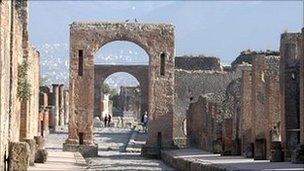Pompeii skeletons reveal secrets of Roman family life
- Published
The remains of the Roman town of Pompeii destroyed by a volcanic eruption in AD79 continue to provide intriguing and unexpected insights into Roman life - from diet and health care to the gap between rich and poor.
The basement storeroom under a large agricultural depot in the little suburb of Oplontis was full of pomegranates. To many of the Pompeiians trying to find shelter from the eruption of Mount Vesuvius, it must have seemed strong and safe.
About 50 people took cover there. We know they did because archaeologists in the 1980s found their skeletons, well preserved.
They were overwhelmed by the volcanic debris and burning gases in the very place where they hoped they would be saved.
We know how these poor people died and we know what killed them. But these skeletons can also tell us fascinating things about how the people in Pompeii actually lived.
There are some very simple surprises.
Syphilis
For a start, we often imagine that the Romans, or anyone in the past for that matter, were all much shorter than we are. Well, not so these people.
In fact, on average, they are taller than the population of modern Naples.
We also imagine that the Romans would have died young. Again, this is another myth - as these skeletons show. There are plenty of middle-aged to elderly people among them.

The AD79 eruption of Vesuvius lasted for over 24 hours and caught the population utterly unprepared
The truth is that childhood was the really dangerous time. All kinds of illnesses that we now vaccinate against or can easily cure with antibiotics were devastating killers.
Only half the population would have made it to the age of 10. But if you got that far, you could look forward to a reasonable life expectancy in our terms.
Interestingly, infectious diseases leave tell-tale marks and lines in the enamel of children's teeth. Many of the skeletons in the cellar show these - a visual history of the illnesses these people had survived.
There are some more curious - and startling - discoveries too.
The skeletons of a pair of twins show what were almost certainly the signs of congenital syphilis. If that is correct, then it puts paid to the usual idea that the disease was brought back to Europe from the New World by Christopher Columbus and his sailors in the 15th Century.
Strong family
That is interesting in itself - we are going to have to stop blaming Columbus, or the Americans, for syphilis.
But the discovery tells us even more about ancient Roman society and Roman families than you might think as Fabian Kanz, the anthropologist from Vienna who examined the bones, points out.
A pair of children with congenital syphilis would need a lot of care and a lot of nursing, he explains.
The simple fact that they survived shows something about the support networks of the Roman world. There were families who were willing and able to devote time, attention and skill to looking after a pair of very sick offspring.
But these 54 skeletons reveal other sides of Roman society too.
As soon as they were unearthed, archaeologists realised that they were in two groups. One lot, on one side of the room, were found with nothing - they were just bodies, with no possessions found with them at all.
The others, on the other side of the room, died with cash, gold and jewels and all kinds of precious objects.
One of these skeletons was discovered with almost the largest amount of money found in one place anywhere in Pompeii. Not a vast fortune in terms of the richest plutocrats from the capital city of Rome itself - Pompeii was a small town remember - but it was someone's very substantial life-savings.
So how do we explain these two groups? Well, archaeology is not an exact science.
It could be that those found without anything were those that had just panicked and ran, and those with the riches had made a more planned getaway.
Or, maybe, that group were criminals, who had done some looting on their way out of Pompeii to Oplontis.
We cannot know for certain. But the likelihood is that we are dealing with a group of the poor with no possessions and of the rich who had jewels and cash.
'Marvellous' diet
It is interesting to see if we can spot differences in the skeletons. Is one group obviously less well nourished? Is one group shorter? The answer is no.
Exploring the archaeology of the town of Pompeii and the surrounding area gives us an idea what life was like for rich and poor.
One conclusion, if you exclude the destitute who had no support networks at all, is that both rich and poor in Pompeii had a decent diet. True, the rich may have had more elaborate dining rooms, but the poor ate decently too.
How do we know? The contents of a cesspit which collected the waste from the lavatories of a block of modest flats in Herculaneum - the next-door town to Pompeii - show that the ordinary people in this block were eating a marvellous diet, from sea urchins to nuts and figs, eggs and chicken.
And, as Andrew Wallace-Hadrill - who excavated this cesspit - agrees, you do not get closer to the Roman world than in its excrement.
Pompeii: Life and Death in a Roman Town will be broadcast on BBC Two at 2100 GMT on Tuesday 14 December, or afterwards on BBC iPlayer.
- Published2 December 2010